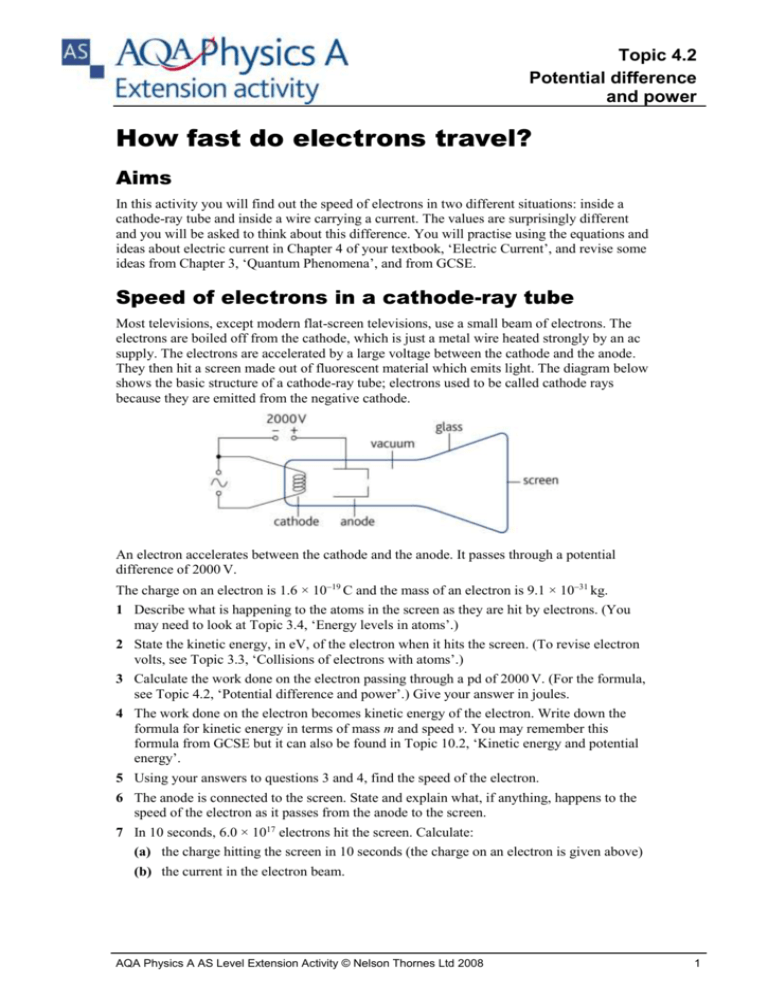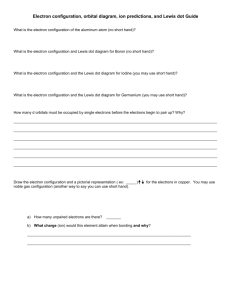AQA AS level Physics A
advertisement

Topic4.2 4.2 Potential difference and power How fast do electrons travel? Aims In this activity you will find out the speed of electrons in two different situations: inside a cathode-ray tube and inside a wire carrying a current. The values are surprisingly different and you will be asked to think about this difference. You will practise using the equations and ideas about electric current in Chapter 4 of your textbook, ‘Electric Current’, and revise some ideas from Chapter 3, ‘Quantum Phenomena’, and from GCSE. Speed of electrons in a cathode-ray tube Most televisions, except modern flat-screen televisions, use a small beam of electrons. The electrons are boiled off from the cathode, which is just a metal wire heated strongly by an ac supply. The electrons are accelerated by a large voltage between the cathode and the anode. They then hit a screen made out of fluorescent material which emits light. The diagram below shows the basic structure of a cathode-ray tube; electrons used to be called cathode rays because they are emitted from the negative cathode. An electron accelerates between the cathode and the anode. It passes through a potential difference of 2000 V. The charge on an electron is 1.6 × 1019 C and the mass of an electron is 9.1 × 1031 kg. 1 Describe what is happening to the atoms in the screen as they are hit by electrons. (You may need to look at Topic 3.4, ‘Energy levels in atoms’.) 2 State the kinetic energy, in eV, of the electron when it hits the screen. (To revise electron volts, see Topic 3.3, ‘Collisions of electrons with atoms’.) 3 Calculate the work done on the electron passing through a pd of 2000 V. (For the formula, see Topic 4.2, ‘Potential difference and power’.) Give your answer in joules. 4 The work done on the electron becomes kinetic energy of the electron. Write down the formula for kinetic energy in terms of mass m and speed v. You may remember this formula from GCSE but it can also be found in Topic 10.2, ‘Kinetic energy and potential energy’. 5 Using your answers to questions 3 and 4, find the speed of the electron. 6 The anode is connected to the screen. State and explain what, if anything, happens to the speed of the electron as it passes from the anode to the screen. 7 In 10 seconds, 6.0 × 1017 electrons hit the screen. Calculate: (a) the charge hitting the screen in 10 seconds (the charge on an electron is given above) (b) the current in the electron beam. AQA Physics A AS Level Extension Activity © Nelson Thornes Ltd 2008 1 Topic4.2 4.2 Potential difference and power 8 The distance between the cathode and the anode is 0.02 m and the distance between the anode and the screen is 0.30 m. Calculate the time taken for an electron to travel: (a) between the cathode and the anode (Hint: use the speed calculated in question 5 but remember that you have to use the average speed because the electrons are accelerating.) (b) between the anode and the screen. Speed of electrons in ordinary wires In the wire shown there are 1.0 × 1023 free electrons. The wire carries a conventional electric current towards the right. Inside the wire the electrons are moving in one direction. Although they move erratically, colliding with the ions in the lattice of the metal, on average they can be considered to be moving at a steady speed, called their ‘drift velocity’. 1 Which way are the electrons moving, to the left or to the right? 2 Calculate the total charge on all the electrons in the wire. (The charge on one electron is 1.6 × 1019 C.) 3 As current flows in the wire, electrons leave at one end of the wire and enter at the other end. If the current in the wire is 2.0 A, calculate the time it will take all the electrons present in the wire at one instant to come out of the end. (Hint: use the answer to question 2 together with the formula that relates charge, current and time.) 4 Use your answer to question 3 and the length of the wire to find the average drift velocity of the electrons in the wire. 5 You may be surprised at how slowly the electrons are moving. Imagine sending an electric current down a wire at the speed you have calculated in question 4. Suppose the electrons travel from London to New York, 5500 km away. (a) How long would it take one electron to travel from London to New York? (b) Does your answer to (a) appear to be a reasonable value? How is it possible to send any electrical signal along a wire, given the value you have calculated in (a)? 6 An electron travels the same distance from the cathode to the screen in a cathode-ray tube as another electron does moving along a wire. Why is the time taken for the electron to travel along the wire so much longer than the time taken by the other electron to travel through the cathode-ray tube? AQA Physics A AS Level Extension Activity © Nelson Thornes Ltd 2008 2 Topic4.2 4.2 Potential difference and power Teachers Notes Aims To find out the speed of electrons in two different situations, inside a cathode-ray tube and inside a wire carrying a current. To understand the difference between unimpeded motion in a cathode-ray tube and the motion of electrons in a metal lattice. To practise using the equations and ideas about electric current in Chapter 4 and to revise some ideas from Chapter 3 and kinetic energy from GCSE. Some items are purely knowledge and comprehension, such as the direction of movement of an electron is in the opposite direction to the electrical current. A chapter reference is usually suggested for the correct formula to be used, making these questions a little more than comprehension. Sometimes students must select their own equation so these questions require application. Students are asked to comment on the values obtained and to put them in perspective. Students will use large negative powers of ten. Teaching notes Students may need to be reminded that electrons move in the opposite direction to the conventional current. They may also need to be given the formula for kinetic energy and be shown how to equate two values of energy to calculate an unknown quantity, in this case the speed. Students will need familiarity with a calculator and finding a square root. Students will need to be reminded of the structure of a metal to realise why electrons travel so slowly in metals. They might benefit from a discussion of the drift velocity superimposed upon a random movement of electrons in all directions; electrons collide with the ions in the lattice, sometimes reversing their direction but always moving towards the positive terminal of a cell. Answers Cathode-ray tube 7 Electrons in the beam hit atoms in the screen. Electrons in the atom are promoted to higher energy levels. As they fall back to lower levels, energy is emitted in the form of light. The energy levels involved in the emission of light are only a few eV apart so there is plenty of energy in each incident electron to cause transition between all of the energy states in the atom. As a result, a number of different energy photons are emitted. 8 2000 eV 9 work done = QV = 1.6 10−19 2000 = 3.2 × 10−16 J 10 1 2 mv2 11 2.7 × 107 m s−1 (This assumes that the mass of the electron has not increased, even though its speed is approaching the speed of light, 3.0 × 108 m s−1.) AQA Physics A AS Level Extension Activity © Nelson Thornes Ltd 2008 3 Topic4.2 4.2 Potential difference and power 12 The speed of the electron is constant. This is because the electron is passing through a region where there is no change in potential and thus there is no change in its kinetic energy. In practice the screen and the anode are both at about 0 V and the cathode is at 2000 V. This ensures that there is little pd between the screen and someone who may come close to it. 13 (a) charge hitting the screen = number of electrons charge on each electron = 6.0 × 1017 × 1.6 × 10−19 = 9.6 × 10−2 C (c) I = Q 9.6 10 2 C = = 9.6 × 10−3 A t s 10 14 average speed = 2.7 10 7 = 1.35 × 107 m s−1 2 (d) cathode to anode: time = 0.02 dis tance = = 1.48 × 10−9 s speed 1.35 10 7 (e) anode to screen: time = 0.30 dis tance = = 1.11 × 10−8 s speed 2.7 10 7 Wire carrying current 1 The electrons are moving to the left. This is because electrons are negatively charged and move in the opposite direction to conventional electric current. 2 total charge = number of electrons charge on each electron = 1.0 × 1023 × 1.6 × 10−19 = 1.6 × 104 C 3 t= 1.6 10 4 Q = = 8.0 × 103 s I 2 4 v= 1 dis tance = = 1.2(5) × 10−4 m s−1 time 8.0 10 3 5500 10 3 dis tance = = 4.4 × 1010 s (which is nearly 1400 years!) v 1.25 10 4 (b) One electron would take a very long time. However, each electron in the wire starts moving in response to the flow of the electric field along the wire; all the electrons start moving almost at the same time. It is as though the wire is like a very long tube full of marbles. If you push another marble very slowly in at one end of the full tube then a marble will appear immediately and slowly at the other end. The signal arrives immediately at the other end. The electric field propagates down the wire at the speed of light in the medium. 6 The speed of the electron in the wire is much less than the speed of an electron in a cathode-ray tube. This is because in the cathode-ray tube there is nothing to impede the electrons. They are accelerated by the pd between cathode and anode, being repelled by the cathode and attracted towards the anode. In the wire the electrons are constantly bumping into the lattice of ions and they build up a slow drift velocity, rather like someone trying to walk through a busy crowd. Also, the pd across the wire is likely to be less than the pd in the cathode-ray tube. 5 (a) time = AQA Physics A AS Level Extension Activity © Nelson Thornes Ltd 2008 4






